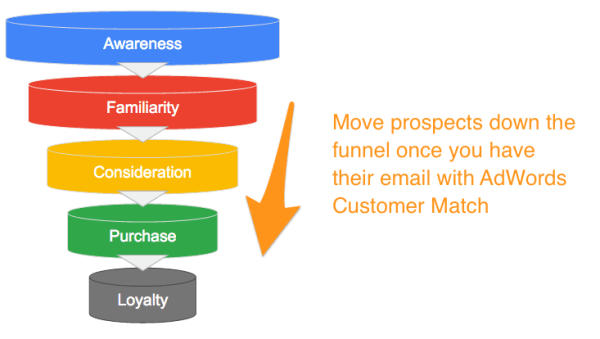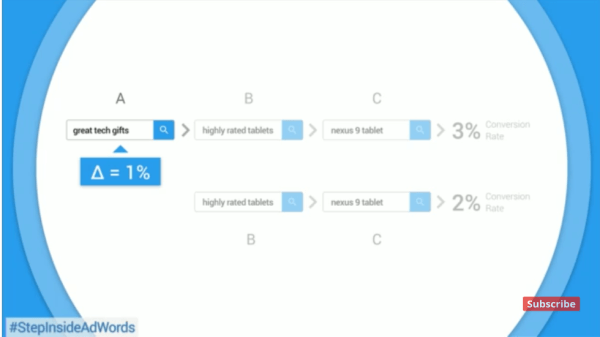11 Things To Do Now To Keep Your AdWords Healthy In 2016
Want to get your AdWords in shape in 2016? Columnist Frederick Vallaeys discusses some top trends and explains what you need to start doing to keep your ads relevant.
At the turn of every year, predictions are made about what the top trends for the next year will be. I contributed my own predictions to articles for a couple of companies, and we wrote up a synopsis of all of the most common predictions for our own blog.
In this post, I will go a little deeper on some of the top trends for advertisers and tell you how to take action today to keep your AdWords accounts in prime shape this year.
Trend 1: Combine Keyword And Audience Targeting
The trend for 2016 that most experts seem to agree upon is that audience targeting will drastically improve the PPC game for search marketers. AdWords grew into a multi-billion-dollar business because it offered hyper-specific targeting through keywords while figuring out a way to ensure ad relevance with Quality Score.
But it always lacked one key element: the ability to get personal by knowing something about the user looking at your ad.
When social networking took off, this shortcoming became more obvious because with Facebook you could target to an audience based on their interests, demographics and online behaviors — all things that AdWords couldn’t do. While it wasn’t necessarily better, it was different, and it exposed a gap in AdWords.
Google tried to answer by getting more personal with their users by introducing Google+, but it wasn’t particularly compelling for advertisers who were more interested in doing better with their search ads than participating in conversations with prospective clients on social media.
Things started to change when Google added audience-based targeting with remarketing in 2010 (Yes, it’s been around for that long!), then RLSA (remarketing lists for search ads) in 2013 and dynamic remarketing in 2014. Audience data could now be used to achieve better results on search by allowing for different bids, and even different ads.
One example of a great way to take advantage of these capabilities today is to add users looking for men’s shoes and women’s shoes on your site to different audience lists. The next time they do a search for a generic term like “running shoes,” you can show different ads and use different landing pages — one for men’s shoes and one for women’s, depending on which list the person is on. Just make sure you set a pretty short duration for this audience list in case they’re shopping for a significant other.
Another way to take advantage of audience lists is to decrease bids or entirely exclude audiences for a lead gen business when the user is already on the list of people who’ve given you their email address. There’s no need to pay for the same lead twice, especially when that second time, they may be looking for how to contact you and they’d be just as likely to click on a local or organic result for your company.
Remarketing’s big downside is that you can only build an audience of users based on what they do on your site. In my example about men’s and women’s shoes, advertisers have to make educated guesses about who their audience is, based on actions they’ve taken.
If I were buying my wife a pair of shoes as a gift and then constantly kept seeing ads for women’s shoes, I’d be pretty annoyed, especially if those ads kept showing up after I had already bought shoes (Columnist Rebekah Schelfhout addresses some fixes for common problems with remarketing.)
Now, Customer Match has addressed this core problem by letting advertisers create audience lists based on email addresses. This means it’s possible to create an audience from people who’ve signed up for a newsletter, from those who put their email address on a sheet of paper in your store or from users in your CRM (customer relationship management) system who’ve spoken to your sales team, even if they never visited your website.
This is a truly powerful addition to the keyword targeting capabilities in AdWords that can help advertisers move prospects down the conversion funnel. AdWords has always been really good at driving traffic at the top of the funnel, when users are starting to show interest in a topic, by doing generic searches like “beach vacation ideas,” and at the bottom of the funnel, when they do specific searches indicating they’re ready to make a purchase, like “four seasons punta mita offers.”

Customer Match lets advertisers target ads based on an email address, making it easier to move prospects through the entire conversion funnel.
Now, an advertiser can capture the email address of an interested user in an early site visit during an upper-funnel interaction, target those prospects with an email drip campaign, and then start a search campaign targeting only those users who haven’t converted yet. Even if conversions happen offline, it’s now easy to target the right audience by submitting the email addresses from unconverted leads in a CRM to AdWords.
Combining the best of keyword targeting with a reliable way to target users based on what you know about them creates a far more powerful system that enables you to execute on novel strategies. While it’s not quite 1-to-1 marketing, it certainly gets us a whole lot closer to that ideal.
You should be doing this in 2016:
- Create several audience-based lists, attach them to many ad groups to start collecting data on the performance of different audience segments, and then set bid adjustments where it makes sense.
- Experiment with customer match audience lists from your customer database.
- Figure out if there are partners who are willing (and allowed) to share their data with you. For example, a car dealer might be interested in knowing whose car is running on its last fumes from a nearby car repair shop. If that partner has permission to share their customer data, there may be ways for you to add those customers to your audience lists.
Trend 2: Automation Gets Custom
I have to admit I didn’t call this out as a big trend for 2016 myself, but I’ve been talking about this theme for years, so I was pleased to see other PPC experts agree.
I presented my take on this theme in 2013 in a presentation about AdWords Scripts. I said that while automation is critical to the happiness and effectiveness of account managers, its big shortcoming is that it is often a cookie-cutter solution built to the lowest common denominator, hence not very good.
Most good third-party automation has settings to allow for some degree of customization, but those customizations are never limitless. When AdWords Scripts came along, all of a sudden it was possible for anyone with some coding skills to take an automation script that someone else built and tweak it to do exactly what they needed.
A good example from our Optmyzr toolbox is a big script I wrote to maintain all of the ad groups, keywords and ads for a campaign based on data in a Google spreadsheet. Our basic solution was generic enough to serve most advertisers, but it wasn’t long before requests for customization started to come in.
Can the script create different ads depending on how many units are in stock? Can it set different starting bids depending on how far we are from the date our sale starts? Can we have different keyword templates depending on the product category? And so on. The answer was always, “Yes, take our script and tweak it.”

Use prebuilt scripts like these from Google as the basis of your own custom automation.
I don’t mean to suggest that these tweaks are easy, but it’s often less work to modify existing code than to write it entirely from scratch and reinvent the wheel, or in this case, to write the function that knows how to create a new ad group, make sure there are no duplicate ads and so on. To make the script custom, usually all one has to do is put in a few simple if-else statements so that it does slightly different things depending on the condition.
It used to be that there weren’t very many script writers out there, but now there are several really good ones, including several SEL columnists like Russ Savage, Daniel Gilbert and me. It is amazing to see all this great code that we can take and turn into exactly the solutions we’ve been looking for. Here’s a recently updated list of great scripts anyone can use from Koozai.
You should be doing this in 2016:
- Look for a library of prebuilt scripts to find solutions that are pretty close to addressing your problems and tweak them. You’ll spend hours on your first one, but it’ll pay off down the road when you save hours no longer doing tedious tasks manually and when your next scripting project goes much more quickly. Check out this great series of articles on how to get started with scripts.
- Learn some basics of programming, or at least how to write specs that an engineer could take to turn your idea into working code.
Trend 3: Structured Data Gets Turned Into Ads
Ads based on structured data saw lots of momentum last year, especially with the phenomenal growth of shopping ads that are based on the data in merchant feeds.
Google also made it easier to customize ads with business data through Ad Customizers or to use Structured Snippets for ad extensions. DSA is another example of structured data driving ads; in this case, the data happens to be Google’s SEO index. I think this momentum will carry well into 2016 and beyond.

Ad Customizers are among the many solutions that let advertisers turn structured data into AdWords ads.
Here’s why I believe this: Structured data frees up account managers’ time to focus on marketing instead of constantly chasing down an ever-changing set of keywords, keeping ads in sync and doing tasks that are really best handled by computers.
It makes sense for advertisers with large accounts to offload repetitive account maintenance to automation while ensuring a more consistent campaign structure. Combining structured business data with templates that specify how to use this data helps achieve that consistency.
I also suspect we’ll see continued growth of new specialty ad formats (like hotel ads and mortgage ads) that rely primarily on data feeds to decide when ads are shown, to whom, and what the ads will say. That way, advertisers can rest assured that they have all their bases covered and can spend more time manually optimizing areas of big opportunity.
You should be doing this in 2016:
- Determine if your business has data that is already structured and could be used for ads. Ask your tech team what databases they have with product data. Or if you have a service business, think about whether your list of locations or services could be put into a structured format.
- Once you have some structured data, explore all of the ways you could integrate it into ads through Ad Customizers, ad extensions or dynamic insertions such as {param1} and {param2}.
Trend 4: Video Ads Take Off
We haven’t yet done much with video ads at Optmyzr, but we know video can be a very powerful advertising channel. The reason many advertisers haven’t done as much with video as they might want is that it was a separate area inside AdWords with some unusual settings that were hard to figure out for someone used to buying text ads and keywords.
Now, YouTube TrueView campaigns have become true AdWords campaigns, complete with ad groups and targeting options that mimic what we’re used to from search and display campaigns, making things much easier to use.
I believe that this move by Google will start a virtuous cycle of more advertisers trying video ads. As Google gets higher coverage for existing inventory, they will follow with innovative ad offerings that will increase the opportunities for advertisers.
A recent innovation that illustrates this is that Google now shows PLA shopping ads on product-related videos. That makes total sense from a usability and relevance perspective, and I think we’ll see many more great ways to use video for advertising.

Shopping Ads can now appear as cards on YouTube by opting into the search partners option of a shopping campaign in AdWords.
Making video ads more similar to the PPC ads we’re already used to also makes it easier for developers like me to extend some of our scripts and automations to the world of video. That, too, will make video advertising more appealing to a larger set of advertisers and drive Google to continue to innovate in this space in 2016.
You should be doing this in 2016:
- Upload some video content about your business to YouTube and embed it on your site. People love videos, and there are many opportunities to get free views before you even start exploring video ads.
- Update your campaign settings to show ads on places other than Google search. Then look at Dimensions reports to see where your ads have shown and where they are working best. You may find ads placed on YouTube perform well at low CPCs. Also try Facebook’s video ads, which are usually even cheaper.
Trend 5: Yesterday’s News Is Today’s News –The Year Of Mobile
This is old news — really old news, actually. Seven years ago, GigaOm said 2009 was the year of mobile, again. It’s now 2016, and it’s the year of mobile — again again. In fact, each of the next 10 years will probably be the year of mobile. As advertisers, we have to have a great mobile experience because that’s where our prospects usually interact with us at some point during the conversion funnel.
The challenge we have ahead of us is to determine how we can measure and attribute results that are driven by mobile. Furthermore, that same challenge applies to offline conversions and micro conversions (those conversions that have some value, even though they’re not sales). Google is changing the definition of the metric “Conversions,” and it will now be a decimal field that measures how we attribute value to each click.

Adwords Data-driven Conversion Attribution models.
Google is helping by providing better data about different ways users convert, but ultimately, it’s up to advertisers to connect Google’s estimates to the reality of their business. This is a hard problem but one worth spending some time on because your competitors are.
If an advertiser decides to only count last-click conversions, they will be undervaluing their keywords compared to an advertiser who uses a more sophisticated attribution model, and that means that they won’t be as competitive in the ad auction because they can’t afford the same CPCs.
There have always been stupid advertisers on AdWords who overpay for CPCs and skew the auction, but eventually reality hits, and they have to cut back, restoring normalcy to everyone’s ad rank. That annoyance will persist when advertisers come up with overly optimistic attribution models skewing the auction landscape.
Unfortunately, that’s the nature of business, and advertisers will have to have their own attribution models right to at least avoid being the ones with bids that are far too high or too low.
You should be doing this in 2016:
- Provide the best experience you can for users on mobile devices. Try to have a mobile-first strategy whenever you build something new. A simple, clean mobile site translates very well to desktop devices.
- Plan for how you will value and measure conversions. When conversions can be counted in AdWords using different attribution models, and when conversions will become decimal numbers, you should be ready to apply this to your account.
Conclusion
So here is a recap of the 11 things I believe advertisers need to start doing today if they hope to keep their ads relevant in the fast-changing world of AdWords:
- Test several audience-based targeting lists.
- Experiment with customer match.
- Find partners to help you create audience lists.
- Install some AdWords Scripts.
- Learn the basics of programming.
- Identify all of your structured data that could be used for ads.
- Leverage structured data ad formats.
- Post video content on YouTube.
- Let Google serve your ads on YouTube.
- Have a mobile-first strategy.
- Build your attribution model.
Opinions expressed in this article are those of the guest author and not necessarily Search Engine Land. Staff authors are listed here.
Related stories
